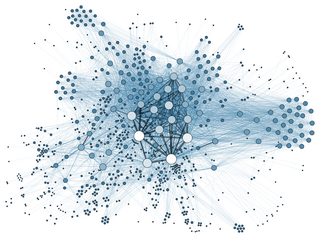An interjection is a word or expression that occurs as an utterance on its own and expresses a spontaneous feeling or reaction. It is a diverse category, encompassing many different parts of speech, such as exclamations (ouch!, wow!), curses (damn!), greetings, response particles, hesitation markers, and other words. Due to its diverse nature, the category of interjections partly overlaps with a few other categories like profanities, discourse markers, and fillers. The use and linguistic discussion of interjections can be traced historically through the Greek and Latin Modistae over many centuries.
Traffic psychology is a discipline of psychology that studies the relationship between psychological processes and the behavior of road users. In general, traffic psychology aims to apply theoretical aspects of psychology in order to improve traffic mobility by helping to develop and apply crash countermeasures, as well as by guiding desired behaviors through education and the motivation of road users.
Sensory evidential mood is one of two kinds of evidential modality. As opposed to reported evidential mood, sensory evidential mood relates the speakers utterances to what the speaker has experienced through their own senses. It is most commonly used to convey what has been heard or seen, but some languages have been reported to include markers for smell.
Emotional contagion is a form of social contagion that involves the spontaneous spread of emotions and related behaviors. Such emotional convergence can happen from one person to another, or in a larger group. Emotions can be shared across individuals in many ways, both implicitly or explicitly. For instance, conscious reasoning, analysis, and imagination have all been found to contribute to the phenomenon. The behaviour has been found in humans, other primates, dogs, and chickens.
The contagion heuristic is a psychological heuristic which follows the law of contagion and the law of similarity, leading people to avoid contact with people or objects viewed as "contaminated" by previous contact with someone or something viewed as bad—or, less often, to seek contact with objects that have been in contact with people or things considered good. For example, people tend to view food that has touched the ground as contaminated by the ground, and therefore unfit to eat, or view a person who has touched a diseased person as likely to carry the disease.
In the linguistic sub-fields of applied linguistics and pragmatics, a hedge is a word or phrase used in a sentence to express ambiguity, probability, caution, or indecisiveness about the remainder of the sentence, rather than full accuracy, certainty, confidence, or decisiveness. Hedges can also allow speakers and writers to introduce ambiguity in meaning and typicality as a category member. Hedging in category membership is used in reference to the prototype theory, to signify the extent to which items are typical or atypical members of different categories. Hedges might be used in writing, to downplay a harsh critique or a generalization, or in speaking, to lessen the impact of an utterance due to politeness constraints between a speaker and addressee.

Rudeness is a display of actual or perceived disrespect by not complying with the social norms or etiquette expected within a relationship, social group, or culture. Social norms are established as the essential guidelines of normally accepted behavior within a given context, and individuals often establish personal boundaries to meet their own needs and desires within smaller settings, such as friendships. To be unable or unwilling to align one's behavior with these norms known to the general population of what is socially acceptable is to be rude. These norms may resemble a sort of "unspoken law", with social repercussions or rewards for violators or advocates, respectively.

Contrastive focus reduplication, also called contrastive reduplication, identical constituent compounding, lexical cloning, or the double construction, is a type of syntactic reduplication found in some languages. Doubling a word or phrase – such as "do you like-like him?" – can indicate that the prototypical meaning of the repeated word or phrase is intended.
"As a rough approximation, we can say that the reduplicated modifier singles out a member or subset of the extension of the noun that represents a true, real, default, or prototype instance."
Dalabon is a Gunwinyguan language of Arnhem Land, Australia. It is a severely endangered language, with perhaps as few as three fluent speakers remaining as of 2018. Dalabon is also known as Dangbon, Ngalkbun, and Buwan.
Behavioral contagion is a form of social contagion involving the spread of behavior through a group. It refers to the propensity for a person to copy a certain behavior of others who are either in the vicinity, or whom they have been exposed to. The term was originally used by Gustave Le Bon in his 1895 work The Crowd: A Study of the Popular Mind to explain undesirable aspects of behavior of people in crowds. In the digital age, behavioral contagion is also concerned with the spread of online behavior and information. A variety of behavioral contagion mechanisms were incorporated in models of collective human behavior.
The principle of evidential existentiality in philosophy is a principle that explains and gives value to the existence of entities. The principle states that the reality of an entity's existence gives greater value to prove its existence than would be given through any outward studies. The principle has become a backbone of the God argument, stating that because God is a self-evident entity, His existence can only be shared by humans, thus proof of God is unnecessary and moot. It appears that the existence is primarily evident to the self only. The God or Supreme self is perceivable to the self. So evidentially self perception is followed by God perception and so on.
Interactional sociolinguistics is a subdiscipline of linguistics that uses discourse analysis to study how language users create meaning via social interaction. It is one of the ways in which linguists look at the intersections of human language and human society; other subfields that take this perspective are language planning, minority language studies, quantitative sociolinguistics, and sociohistorical linguistics, among others. Interactional sociolinguistics is a theoretical and methodological framework within the discipline of linguistic anthropology, which combines the methodology of linguistics with the cultural consideration of anthropology in order to understand how the use of language informs social and cultural interaction. Interactional sociolinguistics was founded by linguistic anthropologist John J. Gumperz. Topics that might benefit from an Interactional sociolinguistic analysis include: cross-cultural miscommunication, politeness, and framing.

Social contagion involves behaviour, emotions, or conditions spreading spontaneously through a group or network. The phenomenon has been discussed by social scientists since the late 19th century, although much work on the subject was based on unclear or even contradictory conceptions of what social contagion is, so exact definitions vary. Some scholars include the unplanned spread of ideas through a population as social contagion, though others prefer to class that as memetics. Generally social contagion is understood to be separate from the collective behaviour which results from a direct attempt to exert social influence.
In linguistics, a backchanneling during a conversation occurs when one participant is speaking and another participant interjects responses to the speaker. A backchannel response can be verbal, non-verbal, or both. Backchannel responses are often phatic expressions, primarily serving a social or meta-conversational purpose, such as signifying the listener's attention, understanding, sympathy, or agreement, rather than conveying significant information. Examples of backchanneling in English include such expressions as "yeah", "OK", "uh-huh", "hmm", "right", and "I see".
Metacognitive therapy (MCT) is a psychotherapy focused on modifying metacognitive beliefs that perpetuate states of worry, rumination and attention fixation. It was created by Adrian Wells based on an information processing model by Wells and Gerald Matthews. It is supported by scientific evidence from a large number of studies.

Hartmut Haberland is a German-Danish linguist and professor emeritus at Roskilde University in Denmark.
An interruption is a speech action when one person breaks in to interject while another person is talking. Linguists, social psychologists, anthropologists, and sociologists are among the social scientists who have studied and identified patterns of interruption that may differ by gender, social status, race/ethnicity, culture, and political orientation.

Felix Ameka (1957) is a linguist working on the intersection of grammar, meaning and culture. His empirical specialisation is on West-African languages. He is currently professor of Ethnolinguistic Diversity and Vitality at Leiden University and teaches in the departments of Linguistics, African Languages and cultures, and African Studies. In recognition of his pioneering work on cross-cultural semantics and his long-standing research ties with Australian universities, he was elected as a Corresponding Fellow to the Australian Academy of Humanities in 2019.
Debra Titone is a cognitive psychologist known for her research on bilingualism and multilingualism. She is currently a Professor of Psychology and a chair holder of Canada Research in Language & Multilingualism at McGill University. Titone is a founding member and officer of the professional society, Women in Cognitive Science. She and her colleagues have written about gender disparities in opportunities, along with the advancement of women the field of cognitive science, with specific reference to Canada.
In linguistics, a rising declarative is an utterance which has the syntactic form of a declarative but the rising intonation typically associated with polar interrogatives.
- Rising declarative: Justin Bieber wants to hang out with me?
- Falling declarative: Justin Bieber wants to hang out with me.
- Polar question: Does Justin Bieber want to hang out with me?







